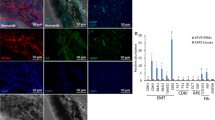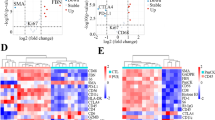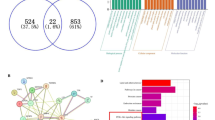Abstract
Purpose
The purpose of the study was to evaluate the efficacy and safety of intravitreal pirfenidone for inhibition of proliferative vitreoretinopathy (PVR) in a model of penetrating ocular injury.
Patients and methods
Penetrating trauma was induced on the retina of rabbit and treated either with 0.1 ml of phosphate-buffered saline (PBS) or 0.1 ml of 0.5% pirfenidone, and development of PVR was evaluated clinically and graded after 1 month. Histopathology and immunohistochemistry with transforming growth factor beta (TGFβ), alpha smooth muscle actin (αSMA), and collagen-1 were performed to assess the fibrotic changes. Expression of cytokines in the vitro-retinal tissues at different time points following pirfenidone and PBS injection was examined by RT-PCR. Availability of pirfenidone in the vitreous of rabbit at various time points was determined by high-performance liquid chromatography following injection of 0.1 ml of 0.5% pirfenidone. In normal rabbit eye, 0.1 ml of 0.5% pirfenidone was injected to evaluate any toxic effect.
Results
Clinical assessment and grading revealed prevention of PVR formation in pirfenidone-treated animals, gross histology, and histopathology confirmed the observation. Immunohistochemistry showed prevention in the expression of collagen-I, αSMA, and TGFβ in the pirfenidone-treated eyes compared to the PBS-treated eyes. Pirfenidone inhibited increased gene expression of cytokines observed in control eyes. Pirfenidone could be detected up to 48 h in the vitreous of rabbit eye following single intravitreal injection. Pirfenidone did not show any adverse effect following intravitreal injection; eyes were devoid of any abnormal clinical sign, intraocular pressure, and electroretinography did not show any significant change and histology of retina remained unchanged.
Conclusion
This animal study shows that pirfenidone might be a potential therapy for PVR. Further clinical study will be useful to evaluate the clinical application of pirfenidone.
Similar content being viewed by others
Log in or create a free account to read this content
Gain free access to this article, as well as selected content from this journal and more on nature.com
or
References
Colyer MH, Weber ED, Weichel ED, Dick JS, Bower KS, Ward TP et al. Delayed intraocular foreign body removal without endophthalmitis during operations Iraqi freedom and enduring freedom. Ophthalmology 2007; 114: 1439–1447.
Meitz H, Heimann K . Onset and recurrence of proliferative vitreoretinopathy in various vitreoretinal disease. Br J Ophthalmol 1995; 79: 874–877.
Sadaka A, Giuliari GP . Proliferative vitreoretinopathy: current and emerging treatments. Clin Ophthalmol 2012; 6: 1325–1333.
Banerjee PJ, Bunce C, Charteris DG . Ozurdex(R) (a slow-release dexamethasone implant) in proliferative vitreoretinopathy: study protocol for a randomized controlled trial. Trials 2013; 14: 358.
Kuo HK, Chen YH, Wu PC, Wu YC, Huang F, Kuo CW et al. Attenuated glial reaction in experimental proliferative vitreoretinopathy treated with liposomal doxorubicin. Invest Ophthalmol Vis Sci 2012; 53: 3167–3174.
Bastiaans J, van Meurs JC, van Holten-Neelen C, Nagtzaam NMA, van Hagen PM, Chambers RC et al. Thrombin induces epithelial-mesenchymal transition and collagen production by retinal pigment epithelial cells via autocrine PDGF-receptor signalling. Invest Ophthalmol Vis Sci 2013; 54: 8306–8314.
Khawly JA, Saloupis P, Hatchell DL . Daunorubicin treatment in a refined experimental model of proliferative vitreoretinopathy. Graefes Arch Clin Exp Ophthalmol 1991; 229: 464–467.
Sundaram V, Barsam A, Virgili G . Intravitreal low molecular weight heparin and 5-fluorouracil for the prevention of proliferative vitreoretinopathy following retinal reattachment surgery. Cochrane Database Syst Rev 2010; (7): CD006421.
Cardillo JA, Timothy SJ, LaBree L, Stanley MS, Azen P, Omphroy L et al. Post-traumatic proliferative vitreoretinopathy. Ophthalmology 1997; 104: 1166–1173.
Pennock S, Haddock LJ, Eliott D, Mukai S, Kazlauskas A . Is neutralising vitreal growth factors a viable strategy to prevent proliferative vitreoretinopathy? Prog Retin Eye Res 2014; 9: 34–37.
Pastor JC, Rojas J, Pastor-Idoate S, Di Lauro S, Gonzalez-Buendia L, Delgado-Tirado S . Proliferative vitreoretinopathy: a new concept of disease pathogenesis and practical consequences. Prog Retin Eye Res 2015; 51: 125–155.
Khan MA, Brady CJ, Kaiser RS . Clinical management of proliferative vitreoretinopathy: an update. Retina 2015; 35: 165–175.
Lin X, Yu M, Wu K, Yuan H, Zhong H . Effects of pirfenidone on proliferation, migration, and collagen contraction of human Tenon’s fibroblasts in vitro. Invest Ophthalmol Vis Sci 2009; 50: 3763–3770.
Chowdhury S, Guha R, Trivedi R, Kompella UB, Konar A, Hazra S . Pirfenidone nanoparticles improve corneal wound healing and prevent scarring following alkali burn. PLoS One 2013; 8: e70528.
Zhang S, Shiels IA, Ambler JS, Taylor SM . Pirfenidone reduces fibronectin synthesis by cultured human retinal pigment epithelial cells. Aust NZ J Ophthalmol 1998; 1: S74–S76.
Choi K, Lee K, Ryu SW, Im M, Kook KH . Pirfenidone inhibits transforming growth factor-β1-induced fibrogenesis by blocking nuclear translocation of Smads in human retinal pigment epithelial cell line ARPE-19. Mol Vis 2012; 18: 1010–1020.
Wang J, Yang Y, Xu J, Lin X, Wu K, Yu M . Pirfenidone inhibits migration, differentiation, and proliferation of human retinal pigment epithelial cells in vitro. Mol Vis 2013; 19: 2626–2635.
Fastenberg DM, Diddie KR, Sorgente N, Ryan SJ . A comparison of different cellular inocula in an experimental model of massive periretinal proliferation. Am J Ophthalmol 1982; 93: 559–564.
McCulloch DL, Marmor MF, Brigell MG, Hamilton R, Holder GE, Tzekov R et al. ISCEV standard for full-field clinical electroretinography (2015 update). Doc Ophthalmol 2015; 130: 1–12.
Algvere P, Kock E . Experimental fibroplasia in the rabbit vitreous. Retinal detachment induced by autologous fibroblasts. Albrecht Von Graefes Arch Klin Exp Ophthalmol 1976; 199: 215–222.
Sugita G, Tano Y, Machemer R . Intravitreal autotransplantation of fibroblasts. Am J Ophthalmol 1980; 89: 121–130.
Chandler DB, Quansah FA, Hida T, Machemer R . A refined experimental model for proliferative vitreoretinopathy. Graefes Arch Clin Exp Ophthalmol 1986; 224: 86–91.
Hitchins CA, Grierson I . Intravitreal injection of fibroblasts: the pathological effects on the ocular tissues of the rabbit following an intravitreal injection of autologous skin fibroblasts. Br J Ophthalmol 1988; 72: 498–510.
Zheng XZ, Du LF, Wang HP . An immunohistochemical analysis of a rat model of proliferative vitreoretinopathy and a comparison of the expression of TGF-β and PDGF among the induction methods. Bosn J Basic Med Sci 2010; 10: 204–209.
Khoroshilova-Maslova IP, Leparskaya NL, Nabieva MM, Andreeva LD . Experimental modelling of proliferative vitreoretinopathy. An Experimental Morphological Study. Bull Exp Biol Med 2015; 159: 100–102.
Nassar K, Lüke J, Lüke M, Kamal M, El-Nabi EA, Soliman M et al. The novel use of decorin in prevention of the development of proliferative vitreoretinopathy (PVR). Graefes Arch Clin Exp Ophthalmol 2011; 249: 1649–1660.
Liou GI, Pakalnis VA, Matragoon S . HGF regulation of RPE proliferation in an IL-1β/retinal hole-induced rabbit model of PVR. Mol Vis 2002; 8: 494–501.
Banerjee S, Savant V, Scott RAH, Curnow SJ, Wallace GR, Murray PL . Multiplex bead analysis of vitreous humor of patients with vitreoretinal disorders. Invest Ophthalmol Vis Sci 2007; 48: 2203–2207.
Hui Y, Shi Y, Zhang X, Yang K, Yu C . TNF-alpha, IL-8 and IL-6 in the early inflammatory stage of experimental PVR model induced by macrophages. Zhonghua Yan Ke Za Zhi 1999; 35: 140–143.
Elner SG, Elner VM, Jaffe GJ, Stuart A, Kunkel SL, Strieter RM . Cytokines in proliferative diabetic retinopathy and proliferative vitreoretinopathy. Curr Eye Res 1995; 14: 1045–1053.
Cui JZ, Chiu A, Maberley D, Ma P, Samad A, Matsubara JA . Stage specificity of novel growth factor expression during development of proliferative vitreoretinopathy. Eye 2007; 21: 200–208.
Danny JH, Meurs KJC, Mertens DAE, Peperkamp E, Master XC, Gerritsen ME . Cytokines in vitreous humor: interleukin-6 is elevated in proliferative vitreoretinopathy. Invest Ophthalmol Vis Sci 1994; 35: 900–906.
Kon CH, Occleston NL, Aylward GW, Khaw PT . Expression of vitreous cytokines in proliferative vitreoretinopathy: a prospective study. Invest Ophthalmol Vis Sci 1999; 40: 705–712.
Morescalchi F, Duse S, Gambicorti E, Romano MR, Costagliola C, Semeraro F . Proliferative vitreoretinopathy after eye injuries: an overexpression of growth factors and cytokines leading to a retinal keloid. Mediators Inflamm 2013; 2013: 269787.
Armstrong D, Augustin AJ, Spengler R, Al-Jada A, Nickola T, Grus F et al. Detection of vascular endothelial growth factor and tumour necrosis factor alpha in epiretinal membranes of proliferative diabetic retinopathy, proliferative vitreoretinopathy and macular pucker. Ophthalmologica 1998; 212: 410–414.
Limb GA, Daniels JT, Pleass R, Charteris DG, Luthert PJ, Khaw PT . Differential expression of matrix metalloproteinases 2 and 9 by glial Muller cells: response to soluble and extracellular matrix-bound tumour necrosis factor-alpha. Am J Pathol 2002; 160: 1847–1855.
Rojas J, Fernandez I, Pastor JC . A strong genetic association between the tumour necrosis factor locus and proliferative vitreoretinopathy: the Retina 4 Project. Ophthalmology 2010; 117: 2417–2423.
Connor TB, Roberts AB, Sporn MB . Correlation of fibrosis and transforming growth factor- type 2 levels in the eye. J Clin Invest 1989; 83: 1661–1666.
Kimoto K, Nakatsuka K, Matsuo N, Yoshioka H . MAPK mediates the expression of type I collagen induced by TGF-2 in human retinal pigment epithelial cells ARPE-19. Invest Ophthalmol Vis Sci 2004; 45: 2431–2437.
Kitaa T, Hataa Y, Aritaa R, Kawaharaa S, Miuraa M, Nakaoa S et al. Role of TGF-B in proliferative vitreoretinal diseases and ROCK as a therapeutic target. Proc Natl Acad Sci USA 2008; 105: 17504–17509.
Yokoyama K, Kimoto K, Itoh Y . The PI3K/Akt pathway mediates the expression of type I collagen induced by TGF-2 in human retinal pigment epithelial cells. Graefes Arch Clin Exp Ophthalmol 2012; 250: 15–23.
Macías-Barragán J, Sandoval-Rodríguez A, Navarro-Partida J, Armendáriz-Borunda J . The multifaceted role of pirfenidone and its novel targets. Fibrogenesis Tissue Repair 2010; 3: 16.
Flores-Contreras L, Sandoval-Rodríguez AS, Mena-Enriquez MG, Lucano-Landeros S, Arellano-Olivera I, Alvarez-Álvarez A et al. Treatment with pirfenidone for two years decreases fibrosis, cytokine levels and enhances CB2 gene expression in patients with chronic hepatitis C. BMC Gastroenterol 2014; 14: 131.
Conte E, Iemmolo M, Fagone E, Gili E, Fruciano M, Genovese T et al. Thymosin β4 reduces IL-17-producing cells and IL-17 expression and protects lungs from damage in bleomycin-treated mice. Immunobiology 2014; 219: 425–431.
Inomata M, Kamio K, Azuma A, Matsuda K, Kokuho N, Miura Y et al. Pirfenidone inhibits fibrocyte accumulation in the lungs in bleomycin-induced murine pulmonary fibrosis. Respir Res 2014; 15: 16.
Hewitson TD, Kelynack KJ, Tait MG, Martic M, Jones CL, Margolin SB . Pirfenidone reduces in vitro rat renal fibroblast activation and mitogenesis. J Nephrol 2001; 14: 453–460.
Jiang Y, Liu L, Pagadala J, Miller DD, Steinle JJ . Compound 49b protects against blast-induced retinal injury. J Neuroinflammation 2013; 10: 96.
Da M, Li KKW, Chan KC, Wu EX, Wong DSH . Distribution of triamcinolone acetonide after intravitreal injection into silicone oil-filled eye. Biomed Res Int 2016; 2016: 5485467.
Falkner CI, Binder S, Kruger A . Outcome after silicone oil removal. Br J Ophthalmol 2001; 85: 1324–1327.
Sun G, Lin X, Zhong H, Yang Y, Qiu X, Ye C et al. Pharmacokinetics of pirfenidone after topical administration in rabbit eye. Mol Vis 2011; 17: 2191–2196.
Rhee DJ, Peck RE, Belmont J, Martidis A, Liu M, Chang J et al. Intraocular pressure alterations following intravitreal triamcinolone acetonide. Br J Ophthalmol 2006; 90: 999–1003.
Blankenship GW . Evaluation of a single intravitreal injection of 5-fluorouracil in vitrectomy cases. Graefes Arch Clin Exp Ophthalmol 1989; 227: 565–568.
Zhong H, Sun G, Lin X, Wu K, Yu M . Evaluation of pirfenidone as a new postoperative antiscarring agent in experimental glaucoma surgery. Invest Ophthalmol Vis Sci 2011; 52: 3136–3142.
Takeda Y, Tsujino K, Kijima T, Kumanogoh A . Efficacy and safety of pirfenidone for idiopathic pulmonary fibrosis. Patient Prefer Adherence 2014; 8: 361–370.
Acknowledgements
We acknowledge the Department of Science & Technology, DST for funding, and West Bengal University of Animal & Fishery Sciences, CSIR-Indian Institute of Chemical for providing facilities.
Author contributions
Conceived and designed the experiments: SH, AK. Performed the experiments: BNMKK, VPS, SN, RG, SH. Analyzed the data: SH, AK. Contributed reagents/materials/analysis tools: SH, AK, SKB. Wrote the paper: SH, AK.
Author information
Authors and Affiliations
Corresponding authors
Ethics declarations
Competing interests
The authors declare no competing financial interests.
Additional information
Supplementary Information accompanies this paper on Eye website
Supplementary information
Rights and permissions
About this article
Cite this article
Khanum, B., Guha, R., Sur, V. et al. Pirfenidone inhibits post-traumatic proliferative vitreoretinopathy. Eye 31, 1317–1328 (2017). https://doi.org/10.1038/eye.2017.21
Received:
Accepted:
Published:
Issue date:
DOI: https://doi.org/10.1038/eye.2017.21
This article is cited by
-
Vitreous humor proteome: unraveling the molecular mechanisms underlying proliferative and neovascular vitreoretinal diseases
Cellular and Molecular Life Sciences (2023)
-
The safety and tolerability of pirfenidone for bronchiolitis obliterans syndrome after hematopoietic cell transplant (STOP-BOS) trial
Bone Marrow Transplantation (2022)
-
Sustained dasatinib treatment prevents early fibrotic changes following ocular trauma
Graefe's Archive for Clinical and Experimental Ophthalmology (2021)
-
Pirfenidone ameliorated AGE-induced EMT and attenuated peritoneal fibrosis in peritoneal mesothelial cells
Molecular & Cellular Toxicology (2021)
-
The Vitrectomy Timing Individualization System for Ocular Trauma (VTISOT)
Scientific Reports (2019)



